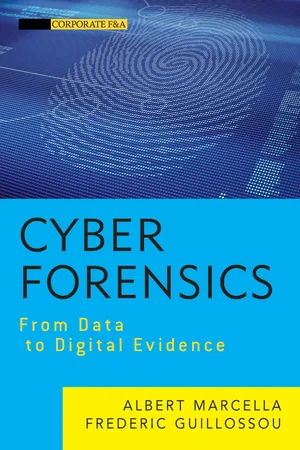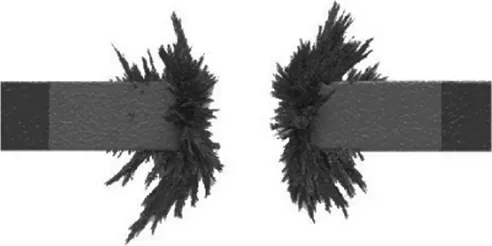
This is a test
- English
- ePUB (mobile friendly)
- Available on iOS & Android
eBook - ePub
Book details
Book preview
Table of contents
Citations
About This Book
An explanation of the basic principles of data
This book explains the basic principles of data as building blocks of electronic evidential matter, which are used in a cyber forensics investigations.The entire text is written with no reference to a particular operation system or environment, thus it is applicable to all work environments, cyber investigation scenarios, and technologies. The text is written in a step-by-stepmanner, beginning with the elementary building blocks of data progressing upwards to the representation and storage of information. It inlcudes practical examples and illustrations throughout to guide the reader.
Frequently asked questions
At the moment all of our mobile-responsive ePub books are available to download via the app. Most of our PDFs are also available to download and we're working on making the final remaining ones downloadable now. Learn more here.
Both plans give you full access to the library and all of Perlego’s features. The only differences are the price and subscription period: With the annual plan you’ll save around 30% compared to 12 months on the monthly plan.
We are an online textbook subscription service, where you can get access to an entire online library for less than the price of a single book per month. With over 1 million books across 1000+ topics, we’ve got you covered! Learn more here.
Look out for the read-aloud symbol on your next book to see if you can listen to it. The read-aloud tool reads text aloud for you, highlighting the text as it is being read. You can pause it, speed it up and slow it down. Learn more here.
Yes, you can access Cyber Forensics by Albert J. Marcella, Frederic Guillossou in PDF and/or ePUB format, as well as other popular books in Business & Accounting. We have over one million books available in our catalogue for you to explore.
CHAPTER ONE
The Fundamentals of Data
THIS BOOK IS DESIGNED to address the fundamental concepts found in the emerging and rapidly evolving field of cyber forensics.
Before one can profess to be knowledgeable and fully cognizant of the breadth encompassing the professional discipline of cyber forensics, a foundation, rooted in the basics of information technology, data storage, handling, and processing, as well as how data is moved and manipulated, is essential.
For the cyber forensic investigator, data is evidence. Understanding how evidence emerges from data is pivotal; however, more important is being able to confidently articulate how evidential data was identified, collected, and processed.
As a cyber forensic investigator, simply pressing buttons or checking off options in a forensic software suite, without the knowledge of what is happening behind the scenes, creates a potential liability. Understanding the “life cycle” of data is pivotal, from its humble beginnings as electronic bits, evolving into bytes, characters, then words, finally emerging as a language, as information, and perhaps eventually as evidence.
This book will provide a platform for both broadening as well as enhancing your skills in the basic elements of information technology as the technology supports and is embedded within the science of cyber forensic investigations.
As you read this book, you will encounter words that have been italicized. These words represent key concepts and are more fully defined by a working definition, which is included within a glossary at the end of the book. Should you desire an explanation of any italicized word, please refer to this glossary.
As with most tasks, one must crawl prior to walking and certainly before dashing off in a full run. Therefore, our first chapter begins naturally, at the beginning, with a discussion of the prime building blocks of data and how as a society we carbon-based humans have learned to communicate with a silicon-based technology—computers.
BASE 2 NUMBERING SYSTEM: BINARY AND CHARACTER ENCODING
Modern humans use character sets (or alphabets) to represent written sounds and words. In many alphabets, including Latin-based alphabets, each symbol or letter has its own phonetic sound.
The letter (or combination of letters, such as “ph”) is paired to its corresponding sound, forming a character code. It is through the combination of these symbols or letters that humans generate words, then phrases, and ultimately complex communication.
Symbolic characters, such as alphanumeric symbols found in Latin-based languages, work reasonably well for the complex computing power of the human brain. Computers, however, have yet to evolve to a level capable of exactly duplicating the complex processing—consistently, seamlessly, and reliably—of the human brain. Currently, computers can best communicate with other computers, in a manner based upon the principles of fundamental mathematics. Computer-to-human communication, while having evolved to a certain degree of voice replication, is still based, again, upon the principles of fundamental mathematics.
The current methodology for digital data transfer is called binary, and it is the basis for all computing technology. In order to understand how computers handle, move, store, access, save, delete, or otherwise manipulate data, it is essential to first understand the concepts of the binary system.
Binary is a name given to a Base 2 numbering system or encoding scheme. As the name Base 2 implies, there are two and only two possible states. In fact, a Base 2 encoding scheme is the only option of communication when only two possible states exist. Such an encoding scheme works well with electronic communication.
Consider electricity, where only two states are present. Electricity is either on or off; there exists no other possible option or state. A circuit is either open or closed. So, if we were to attach a light bulb to an electrical circuit we could visually see when the circuit is open or closed, as the light would either be off or on, respectively (remember, a closed circuit implies closed loop, and is therefore on).
COMMUNICATION IN A TWO-STATE UNIVERSE
Communication in a two-state environment is now possible; the light is either on, equal to “yes,” or it is off, equal to “no.” The potential to answer rudimentary, close-ended questions simply by indicating a response as either “yes” (1) or “no” (0) is entirely feasible.
This is important, being that presently, computers essentially can pass or store information as either electrical or magnetic states. Remember our light bulb can be “on” or “off” only.
Without going into great detail on the basics of electricity or magnetism, perhaps it is necessary to delve ever so gently into the very basic concepts of magnetism and electricity, and their relationship to data construction, storage, mobility, and processing.
ELECTRICITY AND MAGNETISM
Magnetism is the force whereby objects are attracted to or repelled by one another. Usually these objects are metals such as iron. (See Figure 1.1.)
FIGURE 1.1 Magnetic Force

Magnetism can store electricity, as in a battery, for example. Magnetism can also generate electricity (e.g., a generator). Magnetism, as with electricity, has only two states or opposing poles, positive and negative. Magnetic states can also be contained or preserved; for example, the direction of an iron oxide shaving can be manipulated by a magnet. This is called a magnetic domain, which is a series of atoms that point their poles in the same direction. A bar magnet is made up of a ...
Table of contents
- Cover
- Contents
- Title
- Copyright
- Dedication
- Preface
- Acknowledgments
- Chapter One: The Fundamentals of Data
- Chapter Two: Binary to Decimal
- Chapter Three: The Power of HEX: Finding Slivers of Data
- Chapter Four: Files
- Chapter Five: The Boot Process and the Master Boot Record (MBR)
- Chapter Six: Endianness and the Partition Table
- Chapter Seven: Volume versus Partition
- Chapter Eight: File Systems—FAT 12/16
- Chapter Nine: File Systems—NTFS and Beyond
- Chapter Ten: Cyber Forensics: Investigative Smart Practices
- Chapter Eleven: Time and Forensics
- Chapter Tweleve: Investigation: Incident Closure
- Chapter Thirteen: A Cyber Forensic Process Summary
- Appendix
- Glossary
- About the Authors
- Index